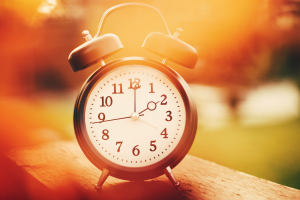Daylight savings time shifts can make an existing sleep disorder worse. The change in time can throw off normal sleeping schedules. At times you may feel as though you have lost sleep or wake up at odd hours and have difficulty getting back to sleep because of the change. However, there are ways to effectively manage a sleep disorder during daylight savings time with proper planning well before a daylight savings time shift is scheduled to occur.
What is Daylight Savings Time?
In the spring clocks are set forward by one hour. In the fall clocks are set back one hour. The goal is to make sunrise and sunlight occur an hour later than the day before, increasing the amount of daylight we have during the evening.
The U.S. is one of 70 countries to participate in Daylight Saving Time (DST). Starting in 1918, “fast time” was introduced and has been utilized since then. The true reason why DST was created was to create a way to save energy and to get more use out of our natural daylight.
What is the Difference Between Daylight Savings Time and Standard Time?
Not everyone agrees that DST is a good idea, considering that changing the clock twice a year disrupts our consistent experience of time in the spring and fall. Many people experience poor sleep during these transitional periods.
However, some places do not use the time change. States like Arizona rely on Standard Time, which is the local time in the region. Daylight Savings Time is not used in Arizona and in many other countries that use Standard Time exclusively.
How Does DST Affect Health and Behavior?
During the times when the clock is set forward or backward an hour, people experience disrupted sleep cycles. While most people easily adjust after a day or so, some people experience health issues. There have been instances where people get cluster headaches, a painful headache on one side of the head during Daylight Savings Time. Disrupted sleep can stimulate appetite causing overeating during the transitional periods. One study found there is a 24% increase in heart attacks a day after the clocks are changed, suggesting greater health risks than just poor sleep.
When Does Daylight Savings Time Begin?
Daylight Savings Time begins on the second Sunday in March. Clocks are moved forward one hour usually around 2 am. Daylight Savings Time ends on the first Sunday of November when clocks are moved back one hour. When clocks are moved forward one hour you can feel as if the day is slightly shorter. In the fall the hour is regained which again affects our sense of time, if only for a day or two until we adjust.
How Does DST Affect Adolescents?
Because of their early school schedule, adolescents may feel the effects of Daylight Savings Time more acutely. Sleep deprivation from the time change can affect mood. Hyperactivity, impulsivity, inattention, acting out behaviors and oppositional behaviors may be the result of sleep loss during the transitional Daylight Saving Time periods.
Lower frustration tolerance and irritability and even some symptoms of depression may appear during Daytime Saving Time. If a teenager already suffers from a sleep disorder, the time change could make it worse.
Tips to Get Good Sleep during Daylight Savings Time
There are ways to still get your rest during Daylight Savings Time. Here are a few tips.
Ease into the transition. Try going to bed 15 minutes earlier than usual to help your body adjust to the change.
Get your sun. Exposure to sunshine can help keep your circadian rhythm on track.
Keep a consistent sleep schedule. Though the time change can throw you off at first, try to go to bed the same time every night to help your body more quickly adapt to the time change.
Try to exercise. A workout can tire you out. You will always sleep better after some time at the gym.
Avoid stimulants near bedtime. Try not to drink caffeinated beverages or even alcohol near bedtime. These substances can keep you awake and ruin your sleep schedule.
Eat light at night. Heavy meals during the evening hours can disrupt healthy sleep. Keep your heaviest meals for the day and eat a light snack well before bedtime.
Conclusion
Having trouble with your sleep? Sleep Care Online may be able to help. We offer a simple, safe, and affordable way to get tested for sleep disorders from the comfort of your home. This comprehensive testing and treatment pathway is designed to seamlessly fit into your lifestyle.
- With the Complete Care Package, schedule a 10-minute telehealth visit with a healthcare provider to discuss your symptoms, upcoming sleep study, test results, and treatment options.
- A multi-night, disposable home sleep apnea test is mailed to your home to be completed at your convenience.
- A physician analyzes the sleep data and provides a prescription if needed.
- Schedule an optional follow-up appointment (additional fee applies).
- We connect you to sleep experts who can offer customized sleep therapy options, assistance in equipment purchase, and initial set-up.





